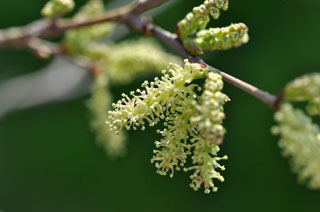WHITE MULBERRY
|
 |
| File Size: 48 KB |
|
|
|
Morus alba L.
|
| Riley County, Kansas |
| Height: To 55 feet |
| Family: Moraceae - Mulberry Family |
| Flowering Period: April, May |
|
| Trunks: | | Erect; branches unarmed; bark reddish brown or yellowish brown, furrows shallow, ridges long, narrow; wood white, soft. | | Twigs: | | Green to reddish green or rust colored, flexible, smooth, usually sparsely pubescent, sometimes glabrous; leaf scars oval to round; sap milky; buds yellowish brown, ovoid, .16 to .24 inch, apex rounded to acute, scales glabrous or sparsely ciliate | | Leaves: | | Alternate, simple, deciduous, both lobed and unlobed on same tree; petiole 1 to 2 inches, pubescent; blade ovate, 2.5 to 4 inches long, 1.2 to 2.4 inches wide; base heart-shaped, wedge-shaped or truncate; margins often irregularly lobed, coarsely toothed; tip short-pointed; lower surface glabrous or primary veins and vein axils pubescent; upper surface glabrous, glossy. | | Flowers: | | Catkins; staminate catkins in leaf axils on new growth, drooping, 5-30-flowered, .4 to 2 inches; peduncles .12 to .8 inch; pedicels absent; pistillate catkins in leaf axils on new growth, drooping to spreading or erect, cylindric, 3-25-flowered, .2 to .6 inch; peduncles .08 to .24 inch, pedicels absent. Flowers unisexual, more or less radially symmetric; staminate: sepals 4-5, distinct, whitish green to greenish yellow, often tinged red, ovate to elliptic, .06 to .08 inch, adaxially pubescent, distally ciliate, apex acute; petals absent; stamens 4; pistillate: sepals 2-4, somewhat connate, calyx becoming fleshy in fruit, lobes green, sometimes tinged white or purple, ovate, distally ciliate, apex acute; petals absent; pistil 1, ovary superior, 2-locular; styles 2. | | Fruit: | | May-June; multiple, white, red, or dark purple, .6 to 1 inch long, .3 to .4 inch thick, glabrous, fleshy; achene 1 per ovary, tan or light brown, flattened-ovoid, .08 to .1 inch. | | Habitat: | | Margins of woods, thickets, fencerows, and disturbed sites. Sometimes planted as shade trees. | | Distribution: | | Throughout Kansas | | Origin: | | Introduced | | Uses: | | The Cherokee used the fruit for food and took infusions of bark as a purgative and laxative. | | Comments: | | White mulberry, the primary food plant of Bombyx mori, the domesticated silk moth, was introduced to North America in the early 1600s with the hope of establishing a silk industry. The oldest collections of Morus alba from Kansas are deposited in the Kansas State University Herbarium and date back to 1884 and 1885. | | | | See red mulberry |
|
| White mulberry staminate and pistillate catkins |  | | 78 KB | | Geary County, Kansas |
| | White mulberry leaves |  | | 95 KB | | Riley County, Kansas |
| | White mulberry leaf |  | | 54 KB | | Riley County, Kansas |
| | White mulberry bark |  | | 121 KB | | Riley County, Kansas |
| | White mulberry leaf |  | | 50 KB | | Riley County, Kansas |
| | White mulberry fruit |  | | 50 KB | | Riley County, Kansas |
| | White mulberry bud and leaf scar |  | | 20 KB | | Riley County, Kansas |
| | White mulberry fruit |  | | 44 KB | | Riley County, Kansas |
| | White mulberry pistillate catkins |  | | 49 KB | | Riley County, Kansas |
| | White mulberry leaf under surface |  | | 77 KB | | Riley County, Kansas |
| | White mulberry bark |  | | 138 KB | | Johnson County, Kansas |
| | White mulberry fruit |  | | 55 KB | | Riley County, Kansas |
| | White mulberry pistillate |  | | 64 KB | | Johnson County, Kansas |
| | White mulberry leaf variation |  | | 118 KB | | Atchison County, Kansas |
| | White mulberry catkins |  | | 96 KB | | Ottawa County, Kansas |
| | White mulberry catkins |  | | 110 KB | | Ottawa County, Kansas |
| | | | |
|
|
|